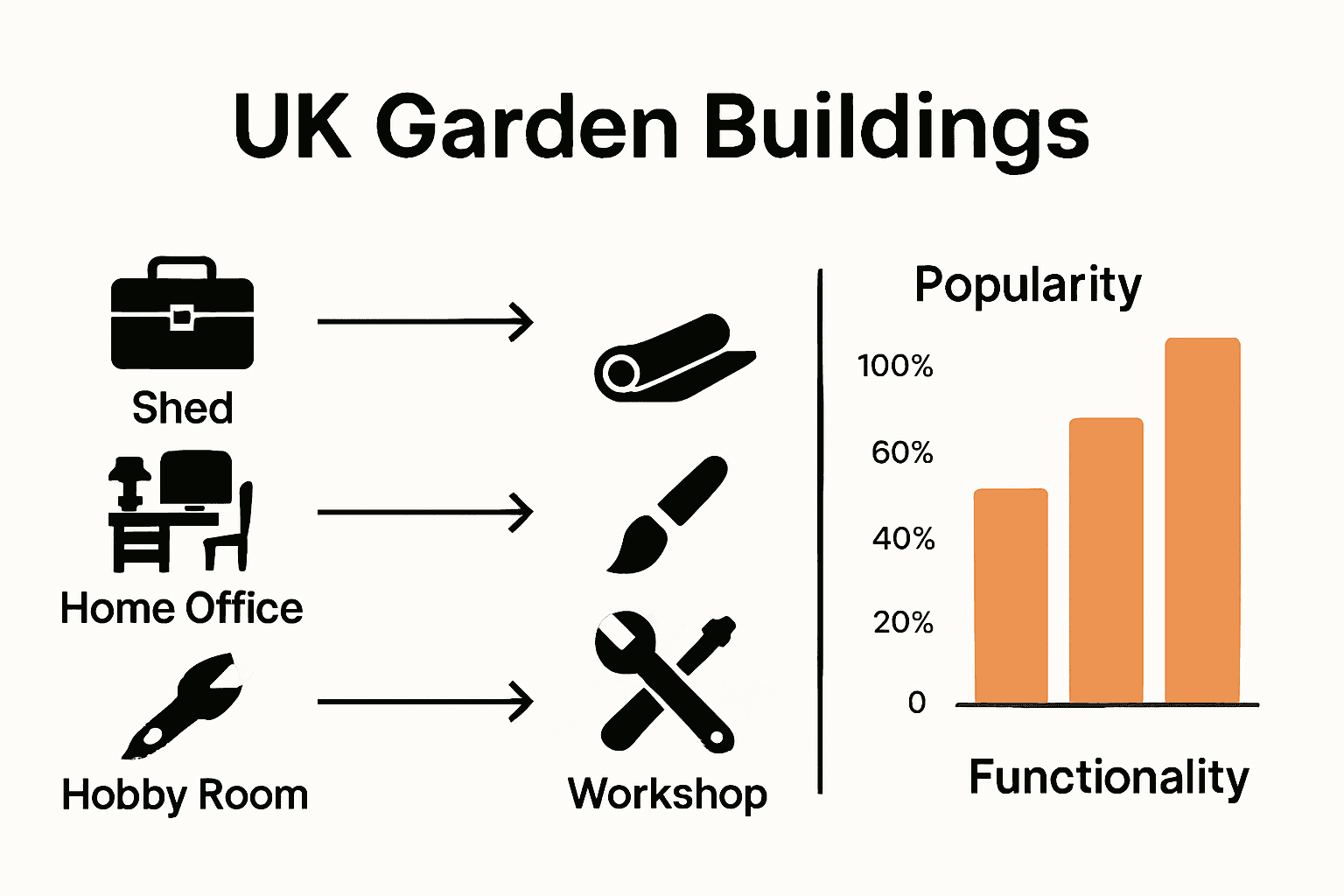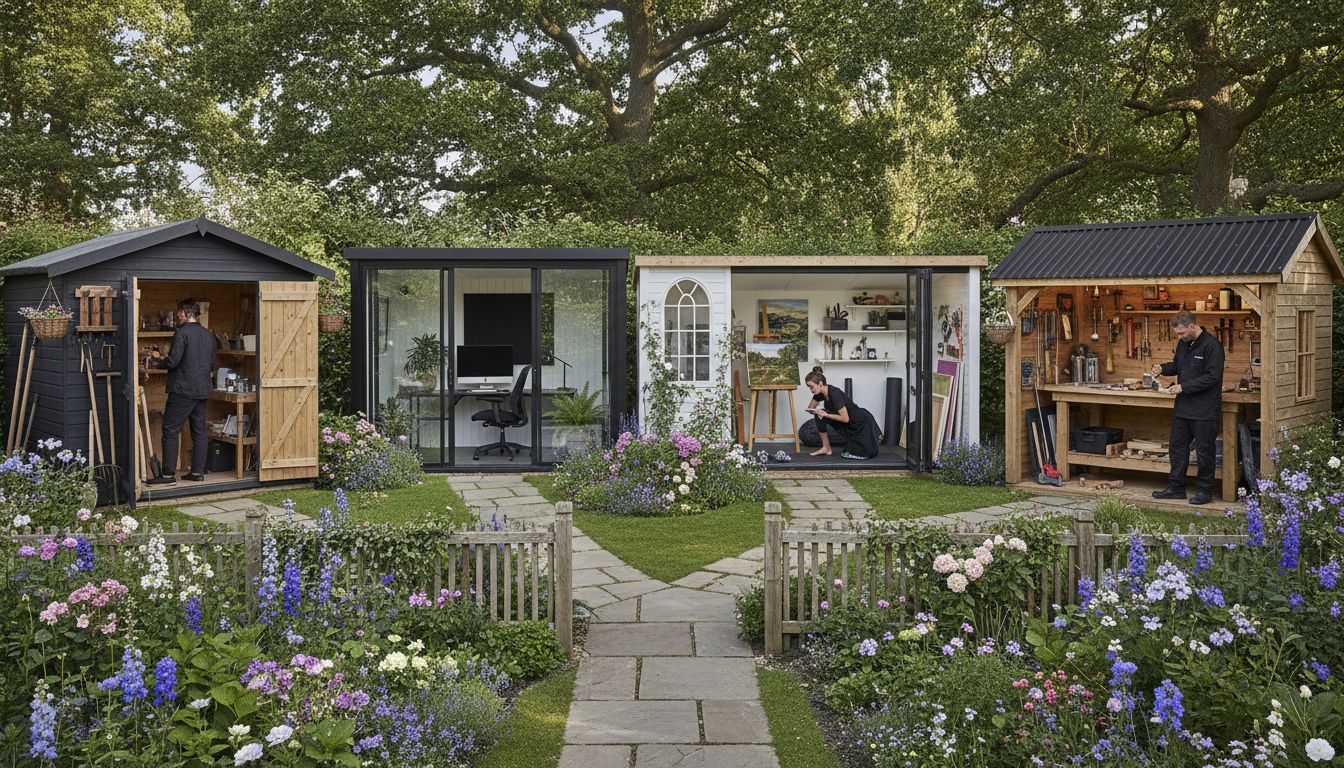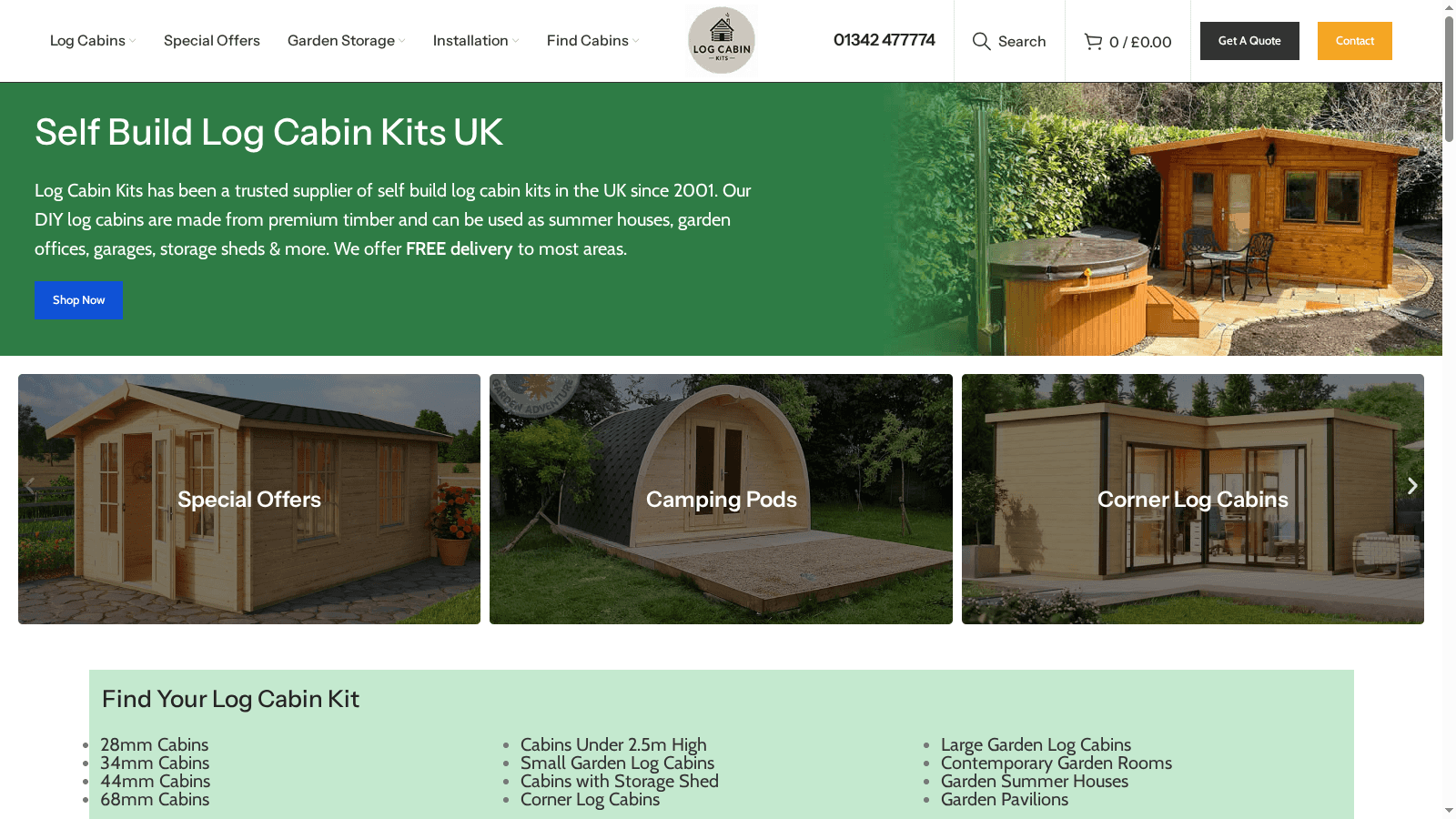Blog
Call Now 01342 477774
What Is a Garden Building? Complete UK Guide

The demand for garden buildings across british homes has soared, with over 40 percent of UK homeowners now investing in these flexible outdoor spaces. This trend reflects more than just a need for extra storage. As lifestyles shift and families seek creative solutions, garden buildings have evolved into valuable assets that offer new ways to work, relax, and enjoy personal hobbies. Whether you want practical advice or inspiration, understanding what defines a garden building in the UK context will help you make smart choices for your outdoor space.
Table of Contents
- Defining Garden Buildings In The UK Context
- Types Of Garden Buildings And Their Uses
- Key Features And Construction Materials Explained
- UK Planning Permission And Legal Requirements
- Costs, Maintenance, And Common Pitfalls
Key Takeaways
| Point | Details |
|---|---|
| Garden buildings are versatile extensions of residential properties | These standalone structures serve various purposes, enhancing functionality and property value beyond traditional storage. |
| Understanding regulations is crucial | Homeowners must navigate planning permissions, building regulations, and guidelines to ensure compliance and avoid legal complications. |
| Investment and maintenance planning are essential | Upfront construction costs, ongoing maintenance, and potential hidden expenses should be carefully considered to protect the value of the investment. |
| Diverse materials offer unique benefits | Choosing the right construction materials, such as timber or metal, can impact durability, aesthetics, and long-term maintenance needs. |
Defining Garden Buildings in the UK Context
A garden building represents a versatile standalone structure purposefully constructed within a residential garden space, offering homeowners an adaptable extension of their living environment. These purpose-built structures range from compact wooden storage sheds to sophisticated multi-functional spaces that can serve as home offices, hobby rooms, workshops, or relaxation retreats.
In the UK context, garden buildings have evolved far beyond traditional storage solutions. Modern garden buildings are sophisticated structures designed to complement existing property landscapes while providing practical additional space. Homeowners increasingly view these buildings as valuable property investments that can enhance both functional utility and overall property value. Bespoke Garden Buildings: Complete UK Guide highlights how these structures have transitioned from simple outdoor storage to multifunctional architectural extensions.
Typically, UK garden buildings are characterised by several defining features:
- Standalone structures separate from the main residential property
- Constructed within residential garden boundaries
- Built using materials like timber, metal, or composite panels
- Designed for specific purposes such as workspace, storage, recreation
- Subject to specific planning and permitted development regulations
The diversity of garden buildings reflects the unique needs of UK homeowners. From compact 2m x 2m storage sheds to expansive 6m x 4m garden studios, these structures offer remarkable flexibility. Understanding local building regulations, planning permissions, and design considerations becomes crucial when selecting or constructing a garden building that seamlessly integrates with your property and lifestyle.
Types of Garden Buildings and Their Uses
Garden buildings encompass a wide range of structures designed to meet diverse homeowner needs, each serving unique purposes that extend far beyond simple storage solutions. From compact tool sheds to elaborate home offices, these versatile spaces represent innovative extensions of living and working environments within residential gardens.
The primary categories of garden buildings in the UK include:
- Storage Sheds: Compact structures for garden tool and equipment storage
- Home Offices: Dedicated workspaces separate from main residential property
- Hobby Rooms: Specialised areas for crafting, art, music, or personal projects
- Garden Studios: Multipurpose spaces for relaxation, exercise, or creative pursuits
- Workshop Buildings: Functional spaces for DIY projects, woodworking, or technical hobbies
Why Build a Multi-Purpose Garden Building? Complete Guide illustrates how modern garden buildings have transformed from simple auxiliary structures into sophisticated, multi-functional spaces that significantly enhance property utility and lifestyle flexibility.
Each garden building type offers distinct advantages tailored to specific homeowner requirements.
 Storage sheds provide practical solutions for keeping gardening equipment and outdoor tools organised, while home offices create quiet, separate workspaces ideal for remote professionals. Garden studios offer serene environments for meditation, yoga, or creative pursuits, demonstrating the remarkable adaptability of these standalone structures.
Storage sheds provide practical solutions for keeping gardening equipment and outdoor tools organised, while home offices create quiet, separate workspaces ideal for remote professionals. Garden studios offer serene environments for meditation, yoga, or creative pursuits, demonstrating the remarkable adaptability of these standalone structures.

The evolution of garden buildings reflects changing work and lifestyle patterns in the UK. With increasing numbers of people working remotely and pursuing home-based hobbies, these versatile spaces have become essential extensions of modern living, offering privacy, functionality, and a seamless connection between indoor comfort and outdoor creativity.
Key Features and Construction Materials Explained
Garden buildings represent sophisticated structures with intricate design considerations, combining functionality, durability, and aesthetic appeal. Orangeries UK highlights that timber frame construction remains the cornerstone of garden building design, offering unparalleled versatility and strength for UK homeowners seeking customizable outdoor spaces.
The primary construction materials for garden buildings typically include:
- Timber: Natural, sustainable, and excellent thermal properties
- Metal: Durable, low-maintenance, and weather-resistant
- Composite Panels: Lightweight, insulating, and modern appearance
- Structural Insulated Panels (SIPs): High thermal efficiency and quick installation
- Glass and Aluminium: For contemporary, light-filled structures
Timber continues to dominate garden building construction due to its remarkable properties. Insulated Garden Building: Complete Guide for the UK emphasises that modern timber structures offer superior insulation, structural integrity, and aesthetic flexibility. Homeowners can choose from various timber types like cedar, pine, and oak, each providing unique characteristics in terms of durability, weather resistance, and visual appeal.
Beyond materials, key features that distinguish high-quality garden buildings include robust foundation systems, comprehensive weatherproofing, integrated ventilation, and adaptable interior configurations. Modern garden buildings are engineered to withstand UK’s challenging climate, featuring advanced sealing techniques, moisture-resistant treatments, and design elements that ensure longevity and performance across changing seasonal conditions.
UK Planning Permission and Legal Requirements
Navigating the legal landscape for garden buildings in the UK requires careful consideration of multiple regulatory frameworks. The Dulwich Estate highlights that garden structures are subject to specific approval processes, with key considerations including size, height, and potential impact on neighboring properties.
The primary legal considerations for garden buildings typically involve:
- Permitted Development Rights: Specific size and location restrictions
- Building Regulations: Structural and safety compliance requirements
- Conservation Area Restrictions: Additional limitations in heritage zones
- Boundary Regulations: Proximity to property lines and neighbors
- Height and Footprint Limitations: Maximum dimensions without formal permission
A Guide on Log Cabin Planning Permission explains that most garden buildings under 2.5 metres in height can be constructed without formal planning permission, provided they meet specific criteria. However, homeowners must carefully navigate several critical restrictions, including total coverage area, proximity to property boundaries, and intended use of the structure.
Understanding the nuanced legal requirements is crucial for UK homeowners. Garden buildings must comply with local authority regulations, which can vary significantly between different councils and regions. Key considerations include maximum floor area (typically 50% of garden space), restrictions on permanent residential use, and ensuring the structure does not obstruct sight lines or create privacy issues for neighboring properties. Consulting local planning authorities and potentially seeking professional advice can help homeowners avoid potential legal complications when installing a garden building.
Costs, Maintenance, and Common Pitfalls
Garden buildings represent significant investments that require careful financial planning and ongoing maintenance considerations. Homeowners must navigate a complex landscape of upfront costs, long-term preservation strategies, and potential hidden expenses that can impact the overall value and functionality of their outdoor structures.
Typical cost considerations for garden buildings include:
- Initial Construction Costs: Ranging from £3,000 to £25,000 depending on size and materials
- Foundation Preparation: £500 to £2,000 for proper ground work
- Interior Finishing: Additional £1,000 to £5,000 for electrical, insulation, and interior design
- Annual Maintenance: Approximately 2-5% of initial build cost
- Potential Utility Connections: £500 to £3,000 for electricity and water
Enhance Your Garden Log Cabin with Premium Grade Doors and Windows highlights that strategic investments in quality materials and finishes can significantly reduce long-term maintenance costs and extend the structure’s lifespan.
Common pitfalls that UK homeowners should anticipate include inadequate foundation preparation, poor moisture management, and overlooking local planning regulations. Timber structures require annual treatment to prevent rot, while metal and composite buildings need specific care to maintain their structural integrity. Homeowners should budget for professional inspections every 2-3 years, implement robust weatherproofing measures, and consider professional maintenance services to protect their investment and ensure the garden building remains a valuable addition to their property.
Transform Your Garden Space with Custom-Built Garden Buildings
Struggling to find extra space that perfectly fits your lifestyle and garden? Modern garden buildings offer flexible solutions that can serve as home offices, hobby rooms, or simply stylish storage. If you have been considering how to enhance your outdoor area while navigating UK planning permissions and maintaining quality, our bespoke garden buildings are designed with your needs in mind. They combine durable materials like timber and insulated panels with smart design features that align with UK regulations and weather demands.

Explore a range of options and create your ideal garden building today by visiting Log Cabin Kits. Whether you want a compact shed or a spacious studio our expert team can help you choose the right model and customisations so you avoid common pitfalls and costly mistakes. Take the next step and bring extra value and function to your property with Bespoke Garden Buildings tailored to your unique requirements. Start your journey now and turn your garden into the versatile space you deserve.
Frequently Asked Questions
Garden buildings include a variety of structures such as storage sheds, home offices, hobby rooms, garden studios, and workshop buildings, each serving distinct purposes to meet homeowners’ needs.
Most garden buildings under 2.5 metres in height can be built without formal planning permission, provided they fit within specific criteria regarding size and location. However, it’s important to check local regulations as they can vary.
Common materials for garden buildings include timber, metal, composite panels, structural insulated panels (SIPs), and glass and aluminium, each offering different benefits in terms of durability and aesthetic appeal.
The initial construction costs for garden buildings can range from £3,000 to £25,000, depending on the size and materials used, along with additional costs for foundation preparation and interior finishing.
